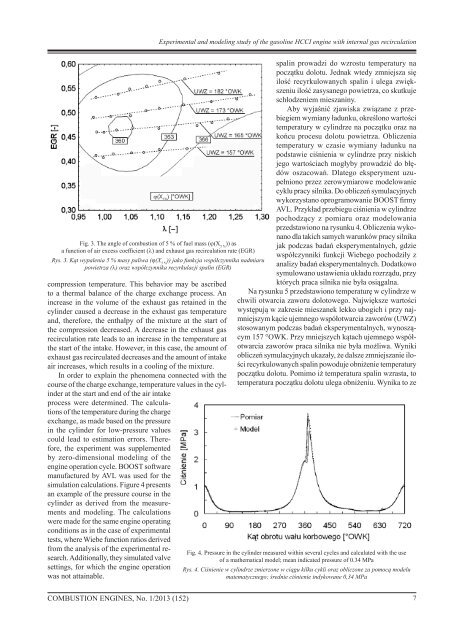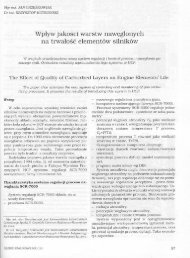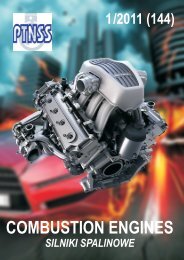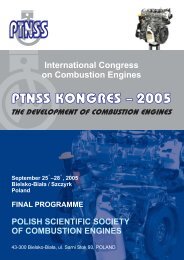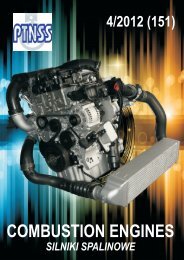You also want an ePaper? Increase the reach of your titles
YUMPU automatically turns print PDFs into web optimized ePapers that Google loves.
Experimental and modeling study of the gasoline HCCI engine with internal gas recirculation<br />
Fig. 3. The angle of combustion of 5 % of fuel mass (j(X 5 %<br />
)) as<br />
a function of air excess coefficient (l) and exhaust gas recirculation rate (EGR)<br />
Rys. 3. Kąt wypalenia 5 % masy paliwa (j(X 5 %<br />
)) jako funkcja współczynnika nadmiaru<br />
powietrza (l) oraz współczynnika recyrkulacji spalin (EGR)<br />
compression temperature. This behavior may be ascribed<br />
to a thermal balance of the charge exchange process. An<br />
increase in the volume of the exhaust gas retained in the<br />
cylinder caused a decrease in the exhaust gas temperature<br />
and, therefore, the enthalpy of the mixture at the start of<br />
the compression decreased. A decrease in the exhaust gas<br />
recirculation rate leads to an increase in the temperature at<br />
the start of the intake. However, in this case, the amount of<br />
exhaust gas recirculated decreases and the amount of intake<br />
air increases, which results in a cooling of the mixture.<br />
In order to explain the phenomena connected with the<br />
course of the charge exchange, temperature values in the cylinder<br />
at the start and end of the air intake<br />
process were determined. The calculations<br />
of the temperature during the charge<br />
exchange, as made based on the pressure<br />
in the cylinder for low-pressure values<br />
could lead to estimation errors. Therefore,<br />
the experiment was supplemented<br />
by zero-dimensional modeling of the<br />
engine operation cycle. BOOST software<br />
manufactured by AVL was used for the<br />
simulation calculations. Figure 4 presents<br />
an example of the pressure course in the<br />
cylinder as derived from the measurements<br />
and modeling. The calculations<br />
were made for the same engine operating<br />
conditions as in the case of experimental<br />
tests, where Wiebe function ratios derived<br />
from the analysis of the experimental research.<br />
Additionally, they simulated valve<br />
settings, for which the engine operation<br />
was not attainable.<br />
spalin prowadzi do wzrostu temperatury na<br />
początku dolotu. Jednak wtedy zmniejsza się<br />
ilość recyrkulowanych spalin i ulega zwiększeniu<br />
ilość zasysanego powietrza, co skutkuje<br />
schłodzeniem mieszaniny.<br />
Aby wyjaśnić zjawiska związane z przebiegiem<br />
wymiany ładunku, określono wartości<br />
temperatury w cylindrze na początku oraz na<br />
końcu procesu dolotu powietrza. Obliczenia<br />
temperatury w czasie wymiany ładunku na<br />
podstawie ciśnienia w cylindrze przy niskich<br />
jego wartościach mogłyby prowadzić do błędów<br />
oszacowań. Dlatego eksperyment uzupełniono<br />
przez zerowymiarowe modelowanie<br />
cyklu pracy silnika. Do obliczeń symulacyjnych<br />
wykorzystano oprogramowanie BOOST firmy<br />
AVL. Przykład przebiegu ciśnienia w cylindrze<br />
pochodzący z pomiaru oraz modelowania<br />
przedstawiono na rysunku 4. Obliczenia wykonano<br />
dla takich samych warunków pracy silnika<br />
jak podczas badań eksperymentalnych, gdzie<br />
współczynniki funkcji Wiebego pochodziły z<br />
analizy badań eksperymentalnych. Dodatkowo<br />
symulowano ustawienia układu rozrządu, przy<br />
których praca silnika nie była osiągalna.<br />
Na rysunku 5 przedstawiono temperaturę w cylindrze w<br />
chwili otwarcia zaworu dolotowego. Największe wartości<br />
występują w zakresie mieszanek lekko ubogich i przy najmniejszym<br />
kącie ujemnego współotwarcia zaworów (UWZ)<br />
stosowanym podczas badań eksperymentalnych, wynoszącym<br />
157 °OWK. Przy mniejszych kątach ujemnego współotwarcia<br />
zaworów praca silnika nie była możliwa. Wyniki<br />
obliczeń symulacyjnych ukazały, że dalsze zmniejszanie ilości<br />
recyrkulowanych spalin powoduje obniżenie temperatury<br />
początku dolotu. Pomimo iż temperatura spalin wzrasta, to<br />
temperatura początku dolotu ulega obniżeniu. Wynika to ze<br />
Fig. 4. Pressure in the cylinder measured within several cycles and calculated with the use<br />
of a mathematical model; mean indicated pressure of 0.34 MPa<br />
Rys. 4. Ciśnienie w cylindrze zmierzone w ciągu kilku cykli oraz obliczone za pomocą modelu<br />
matematycznego; średnie ciśnienie indykowane 0,34 MPa<br />
<strong>COMBUSTION</strong> <strong>ENGINES</strong>, No. 1/2013 (152)<br />
7


